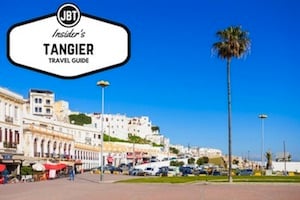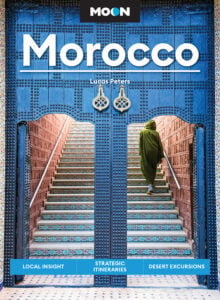
Here are the most common questions we receive about driving in Morocco: A: Is driving in Morocco is safe? B: Are the roads good? C: Do you need an international driver’s license? D: Is it possible to rent a good car.
In short, the answers key is as follows:
A: For the most part.
B: Mostly.
C: No.
D: Yes.
Driving in Morocco: General Road Conditions
When we talk about overall safety, we usually think of two things: The general maintenance of the road system and other drivers.
As you might expect, there is a clear difference in standard between driving in Morocco and driving in Australia, Europe or North America. There are more erratic, aggressive drivers. Not to mention all sorts of vehicles — from semi-trucks to bicycles to donkey carts — are legally allowed to share a road. You will also see plenty of pedestrians, herd animals (think: sheep, cow, and camel), scooters, bicycles, wheelchair users, horse-drawn carriages and others sharing the thoroughfares of Morocco.
So… driving can be a bit chaotic and drivers should really be aware at all times, though once you get used to it, it sounds more nuts than it is.
With this in mind, the road system in Morocco is more organized than some other African countries, to say nothing of some countries in Asia.
Roads run the gamut of pristine and well-maintained roads that would look the part in Switzerland to strips of asphalt that look as though they’ve been detonated with landmines. Some of this depends on the time of year and where in the country you’re traveling. In general, the paid autoroutes (freeways) are better than their American counterparts while more rural mountain roads or in parts of the Sahara are generally the worse strips of macadam found in the country, particularly in winter and spring when they are dealing with snow and possible flooding.
That said, with a good car or SUV, road-tripping through Morocco can be a wonderful way to get off the path beaten by the trains and buses and find pieces of this stunning country that are less explored. Those who have driven in other parts of North Africa, India, or even around the Mediterranean, will be right at home driving in Morocco. In fact, our friends from Spain and Italy find driving in Morocco to be a relatively calm experience.
Driving in Morocco: City Traffic
While you are driving in the countryside or on the paid autoroutes, you’ll likely experience minimum traffic. The worst offender will likely be a slow-moving truck chugging uphill on a mountain pass. Generally, the only real traffic on autoroutes is between Rabat and Casablanca.
However, traffic in the cities of Morocco is another beast entirely. Driving in unfamiliar urban terrain, such as Casablanca or Tangier, can be a stressful experience for anyone, including Moroccan drivers. The roads are often unsigned, making navigations, even with a GPS, a bit tricky.
Many city intersections comprise of one large roundabout. There is a seemingly lack of order as cars, buses, trucks, donkey carts, et cetera, all circle round with drivers zipping from the far left lane to take a quick right and vice-versa. Due to traffic and the apparent lack of order, so it’s important to practice defensive driving skills.
Knowing all of this in advance can help a lot. Plan in extra time for traffic jams, particularly in Casablanca. And plan to get turned around once or twice, at least. In the venerable words of Douglas Adams, perhaps the best ever travel writer: Don’t Panic!

Driving in Morocco: Other Drivers
The legal driving age in Morocco is 21. Driving school, a comprehensive written test, and a performance test are all required by the government to earn a driving license. However, many Moroccan drivers have simply paid a small bribe to have their license issued, bypassing the school and test. Therefore, many drivers you share the road with are unaware or have little background knowledge of basic traffic laws, which often go unobserved. Drivers sometimes pass on blind turns, run red lights, and will straddle two lanes on the paid autoroute. In the cities, the aggression is compounded. It you’re visiting Morocco during Ramadan in the hour leading up to ftour (the breaking of the fast, which happens at sundown), and streets are unmarked, adding to the confusion.
For the most part, the other drivers you might encounter will only impact your driving in urban spaces. Again, defensive driving is key.
Driving in Morocco: Night Driving
Unless you know the roads of Morocco very well, night driving should be avoided if possible.
In the countryside, there are few street lights. Often, herders with camels, sheep, goats, and cows try crossing streets after dark, making the possibility of hitting livestock a real concern. Keep in mind that the signage, generally in Arabic and French (though occasionally only in one or the other language) is not usually lit, making following turnoffs and other directions that much more difficult.
Driving in Morocco: General Tips
- The speed limit on the autoroutes is typically 120 kilometers (75mi) per hour. Beware of speed traps and police who walk out onto the road (even the autoroutes!) to halt speeders.
- Keep a copy of your passport and your original driver’s license on you at all times. A typical driving infraction will set you back 400Dh. You will be given a receipt for this and are expected to pay in cash the fine on the spot. If you are unable to pay the fine, your ID may be confiscated and taken to the local court for you to pay the fine there. You do not need a special “international license” to drive in Morocco or rent a car.
- Gasoline isn’t exactly cheap in Morocco (12Dh a liter, around 25Dh a gallon), though it is subsidized by the government. Consider renting a newer, fuel-efficient diesel car. Diesel is slightly cheaper (less than 9Dh a liter, around 20Dh a gallon), and a new diesel engine can fetch nearly double the mileage of unleaded engines. You can even go electric, though this has to be done with some forethought if traveling to the Sahara region.
- Always fill your car up to the maximum whenever stopping at a station, particularly in the rural areas and in the desert, as sometimes stations can be far apart.
- Always wear your seat-belt. Laws have been implemented. Though enforcement is relatively moderate, stops do occur. Drivers are held responsible for all occupants in a vehicle.
- The permitted Blood Alcohol Concentration (BAC) extremely low at only 0.02%, so do not drink and drive under any circumstances.
- Plan for longer driving times than your GPS or online maps, like Google Maps, indicates. And keep in mind that if you’re making your way to/from the Sahara, you will have some long days of driving. Plan accordingly.
Driving in Morocco: Renting a Car
You’ll find car rentals in every major airport. You can easily rent a car through any of the major companies (Avis, Buget, Hertz, etc.) online. It’s generally better (and cheaper) to arrange your rental ahead of time. Cars range from compact, two-wheel drives to enormous SUVs and luxury sedans. Prices typically from 100Dh – 500Dh a day, without insurance.
You will want to make sure you are insured while driving in Morocco. Oftentimes, your travel insurance will cover this and some credit cards automatically include coverage. Check with your provider. If you do not have insurance, all rental companies in Morocco offer insurance, though at a premium rate.
If you’re renting a car and want to visit, either to or from Spain, your car will not be allowed to cross the boarder. This goes even for the Moroccan exclaves of Ceuta or Melilla.
Driving in Morocco: Driving Your Car in Morocco
For those coming from Europe, it is possible to cross from Spain into Morocco with your car or campervan. You will want to make sure you have international driving insurance from your insurance provider. It’s a good idea to have also have a tune-up before you travel. Make sure to bring all your car papers, including proof of insurance and proof of ownership. It’s also a good idea to keep copies of these papers with a copy of your passport, just in case.
Daily ferries cross the Strait of Gibraltar from Tarifa and Algeciras via the companies Baleària and Africa Morocco Link. Tarifa is the better crossing for most travelers. The Tarifa ferry arrives directly into Tangier at the bottom of the Tangier medina. It is quicker crossing (less than an hour) than the crossing at Algeciras, which lands at Tangier Med, about an hour to the east of Tangier and takes around 2 hours). Because the Tarifa ferries are smaller and don’t deal with large cargo trucks, boarding and deboarding is also much quicker.
About the Author

Written by Morocco expert, award-winning author and photographer Lucas Peters. After spending years driving in a combination of rental cars and an old Honda CRV to the distant corners of Morocco, he pens the popular Moon Morocco. He lives in Morocco with his family… and these day drives a 2022 Jeep Wrangler 4XE plug-in electric, to and from Europe and all around Morocco.








